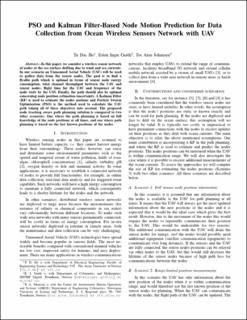PSO and Kalman Filter-Based Node Motion Prediction for Data Collection from Ocean Wireless Sensors Network with UAV
Peer reviewed, Journal article
Accepted version

Åpne
Permanent lenke
https://hdl.handle.net/11250/2992648Utgivelsesdato
2021Metadata
Vis full innførselSamlinger
Originalversjon
IEEE International Symposium on Consumer Electronics. 2021, . 10.1109/ICCE50685.2021.9427697Sammendrag
In this paper, we consider a wireless sensor network of nodes at the sea surface drifting due to wind and sea currents. In our scenario an Unmanned Aerial Vehicle (UAV) will be used to gather data from the sensor nodes. The goal is to find a flyable path which is optimal in terms of sensor node energy consumption, total channel throughput between the UAV and sensor nodes, flight time for the UAV and frequency of the node visits by the UAV. Finally, the path should also be optimal concerning node position estimation uncertainty. A Kalman Filter (KF) is used to estimate the nodes motions and Particle Swarm Optimization (PSO) is the method used to calculate the UAV path taking all of these objectives into account. The proposed node tracking aware path planning solution is compared to two other scenarios: One where the path planning is based on full knowledge of the node positions at all times, and one where path planning is based on the last known positions of the nodes.